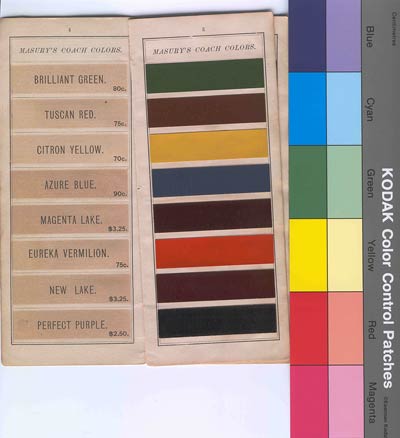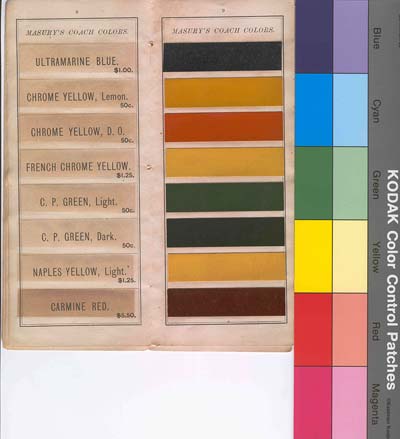

1877 Masury Paint Catalog
From Randy Hees Collection, Scans And Text By Craig Hoefer.John Wesley Masury (1820-1895) was a successful paint manufacturer who also invented and patented a number of paint-industry innovations, including a water-cooled method of grinding pigments, metal paint containers and the lip-closure on paint cans, still referred to as the dripless can, that made the marketing of ready-mixed paints feasible. The letters patent granted to John W. Masury, July 12th, 1859, for an improvement in paint cans. The claim of the patent:
The construction of a metallic can, for hermetically sealing paints and other substances, having attached thereto a rim or ring of thin brass or other soft metal, in such a manner that the top or cover may be removed by severing the said rim or ring of brass or other soft metal with a penknife or other sharp instrument, in the manner and for the purposes ...
The result? An enormous growth of the paint industry then began in the 1860s, stimulated by the above invention of modern the paint can. The first factory-made paints in cans consisted of more finely ground pigments in an oil base; after purchase, additional oil was added to the contents of the can to make up the paint. Such paints saved the time of handgrinding pigments. After 1875, factory-made paints were available at a reasonable cost and, as a result, greater numbers of people painted and decorated more of their buildings, and more frequently. The new commercial market created by ready-mixed paint became the cornerstone of the modern paint industry. The company became "John W. Masury & Son" in the 1870's. During the 20th Century the company added Automotive paints to the product line. In 1947, C. M. Athey Paint Company ("C.M. Athey") acquired the property from John Masury and Sons. The Masury Paint Co, was purchased by The Valspar Paint Corp. in April of 1979.
Complete Palette of Car Body and Trim Colors of John W. Masury & Son, Co. 1877.
High resolution scan of the original Sample Book.This Catalog exhibits a number of pigments of interest to railroad historians, restorers, and modelers as Masury was one of the primary suppliers of Railroad Paints.
The Carbody Color is the leading candidate for many roads that had Yellow, Buttercup Yellow, and similarly colored cars.
The Lake that frequently appears in discussions on modeling groups is actuall a family of colors, actually a color treatment. No less than eleven variation examples appear in the catalog. As much as anything, the Lakes were a two part color treatment involving a base color topped by a glaze. The Lakes have an ancient history, primarily as a means of extending color ranges.
They had a downside in regards to railroad usage. The organic paints were prone to fading with exposure to sunlight. They were also difficult to maintain and repair when damaged. In part, color matching due to fading, and the matching of the glazing was difficult. Railroads had largely switched to solid colors by the 1880's as a result.








